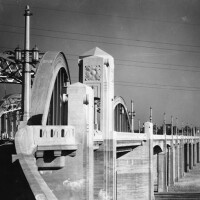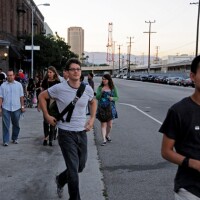Sixth Street Bridge Replacement Project Breaks Ground; Surfaces a Tale of Two Neighborhoods

The Sixth Street Bridge is as close to a celebrity in Los Angeles as the starlets that roam the city, perhaps even more so because of its role in film, television, commercials, and music videos such as Grease, Terminator 2, Terminator 3, and many others. On this cloudy day, a crowd gathered to bid adieu and to welcome the new.
"This is an example of the type of infrastructure I'm committed to building in Los Angeles," says Los Angeles Mayor Eric Garcetti, who was joined by Councilmember José Huizar, Congressmember Xavier Becerra, State Senate President Pro Tem Kevin De León, Assemblymember Miguel Santiago, and Gary Lee Moore from the Bureau of Engineering (BOE).
Though every public officer gathered at the event expressed dismay at the "concrete cancer" that necessitated the demolition of this iconic bridge, each one was as equally optimistic that the planned $440 million bridge designed by Michael Maltzan Architecture and HNTB would not only provide a "point A to point B, but a point C," says Huizar, in whose district the project falls into. "It will be a destination itself that people come to visit."
Read more about the Sixth Street Bridge
According to Huizar's planning director Tanner Blackman, the groundbreaking heralded the actual start of the construction phase for the project. Residents won't see a dramatic crashing of the bridge, but over the summer the city will be undergoing intersection improvements, adding traffic signals, and re-routing traffic to Fourth and Seventh street bridges.

Keen-eyed residents will also be seeing parts of the bridge come down bit by bit, a little like a "disappearing bridge" act. Over the next four-year project timeline, the city also plans to construct an Arts Plaza in the Arts District that officials hope would become an amphitheater space. In the Boyle Heights side, Huizar also secured $1 million to fund the construction of a soccer field below the bridge.
Despite the beautiful, unbelievably expansive model displayed during the groundbreaking, which gave residents a glimpse of the bridge's multi-modal ambitions, there seems to be a tale of two neighborhoods unfolding.
"If they're going to have to make a change based on the cost to repair the old bridge and the 'cancer' in it, then this is a fantastic project to have in its place," says Cindy Schwarzstein, an Arts District resident and a Los Angeles River Artists and Business Association (LARABA) board member. Schwarzstein was filled with optimism at the prospect of the bridge's construction.
Residents from Boyle Heights, however, weren't as enthused. Jason Gallegos of the Boyle Heights Planning and Land Use committee similarly understood the necessity of demolishing the Sixth Street Bridge, but says "We want the city and developers to keep us updated. We just need to know what's going to happen. How are they re-routing traffic, details like that."

Boyle Heights resident, tour guide, and writer Shmuel Gonzales takes an even more confrontational stance. As his friend holds up a sign that says "The new bridge sucks," Gonzales explains, "Every day people on the other side [Boyle Heights] are wondering what's going to happen. Businesses are anxious. We don't know what the future is and the city didn't give us any information."
Gonzales says that even today, residents of Boyle Heights still don't understand that the Sixth Street Bridge, a "symbol of the Golden Age of Boyle Heights," according to Gonzales, will eventually disappear. He adds that his neighborhood seems to be getting short shrift, receiving less that the amenities being planned for the Arts District side. He even notes that during the groundbreaking only about a dozen people from Boyle Heights were present. "We're hopeful," says Gonzeles, "but there has to be a dialog."
A bridge is always used to connect one place to another, but in the case of the future Sixth Street bridge, it seems that it's ironically becoming a divisive symbol that needs to be addressed.


